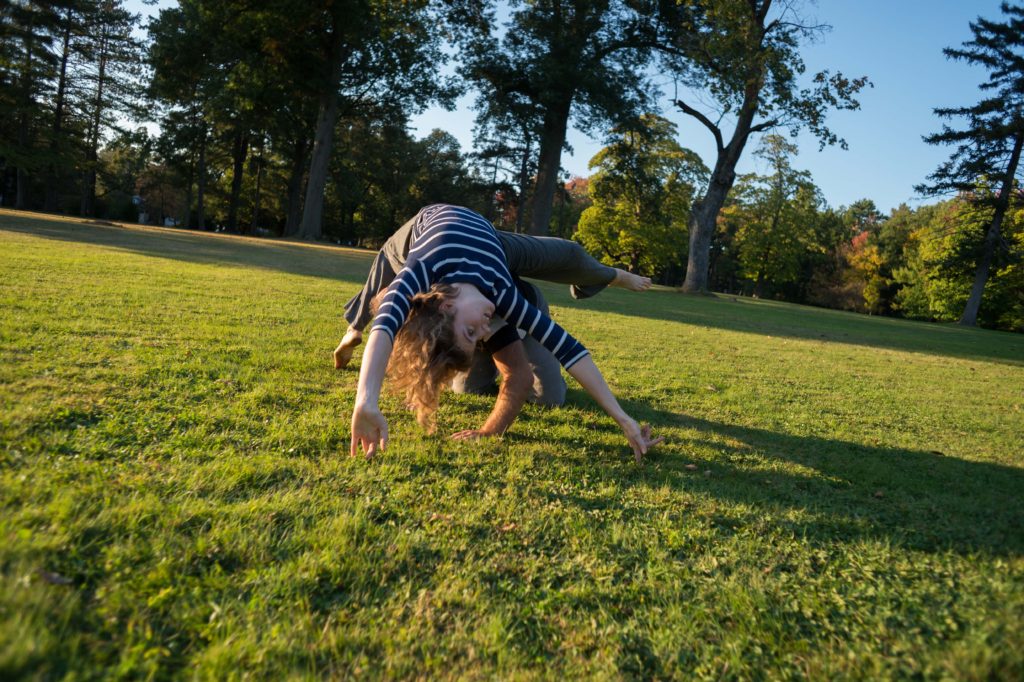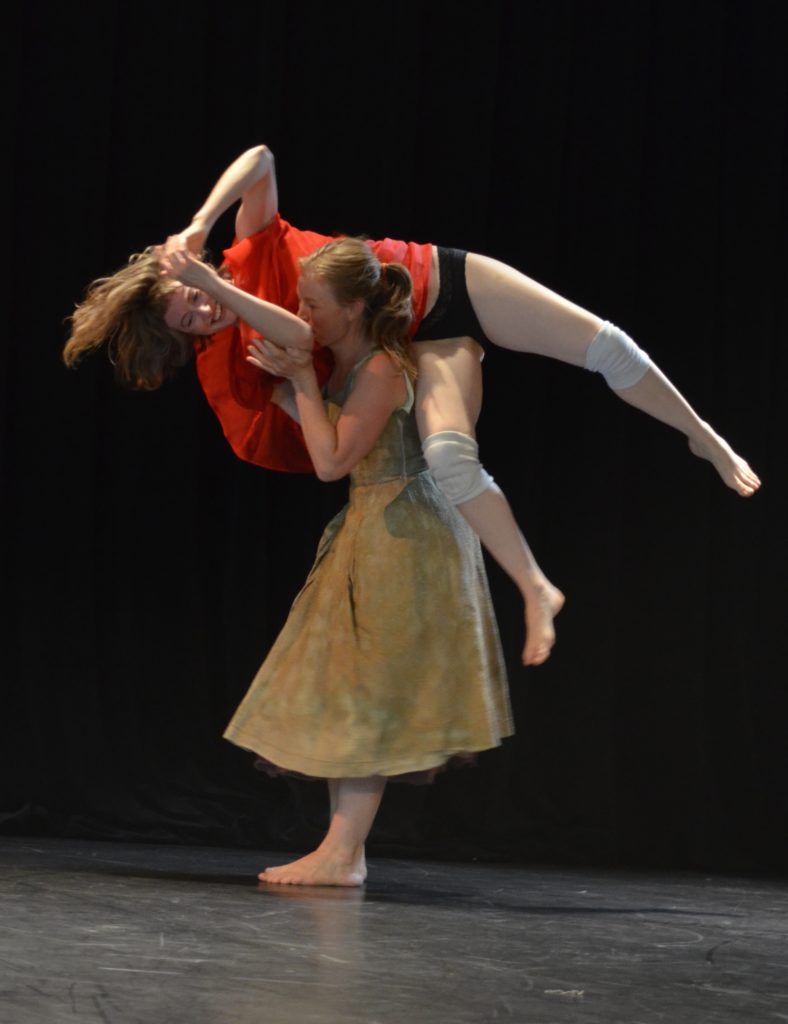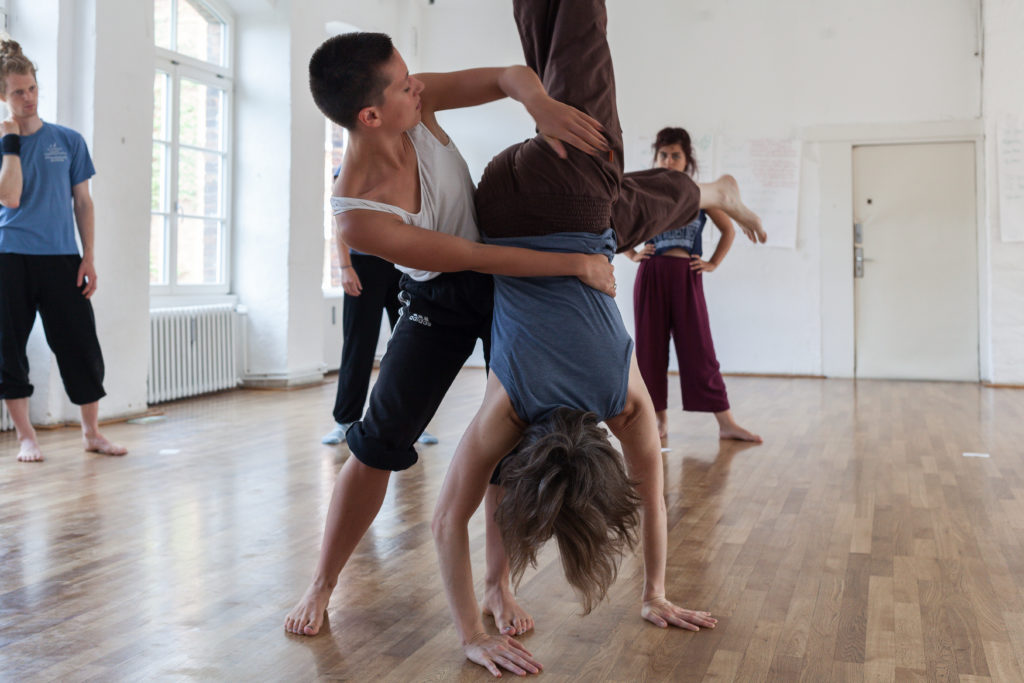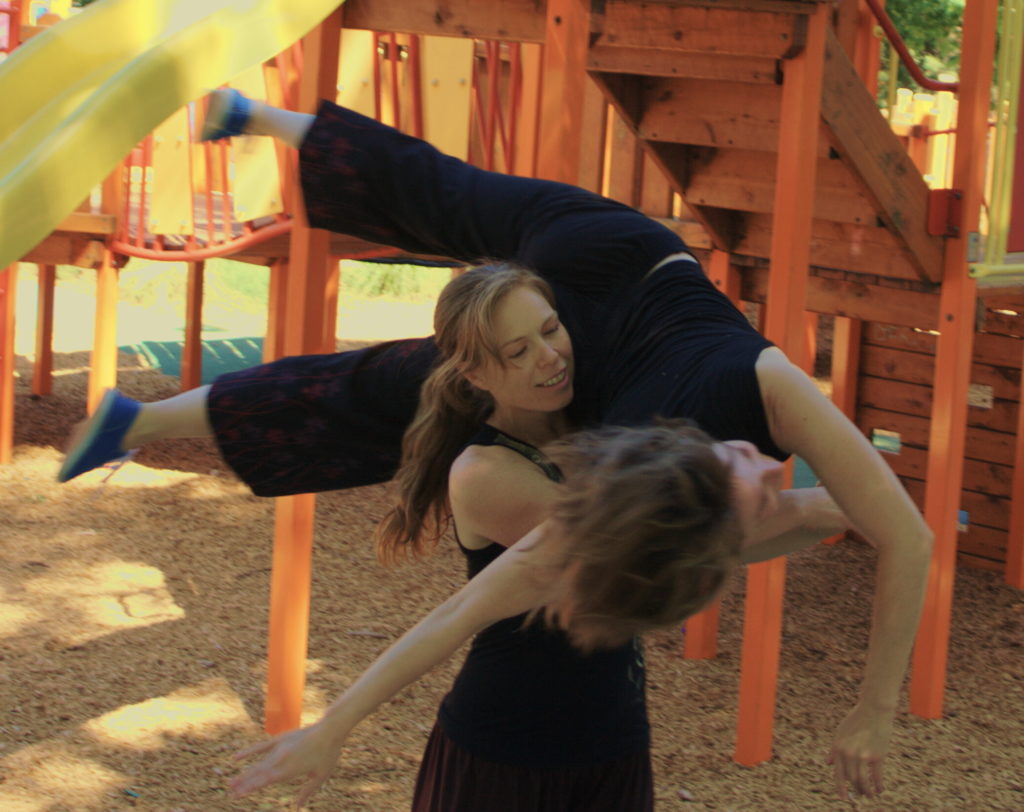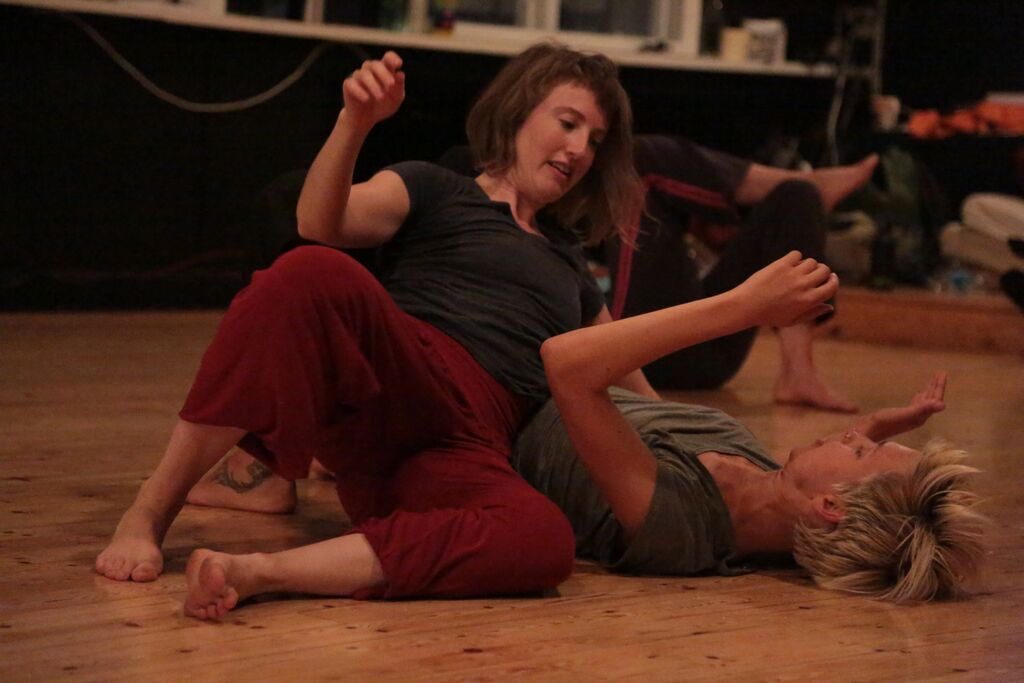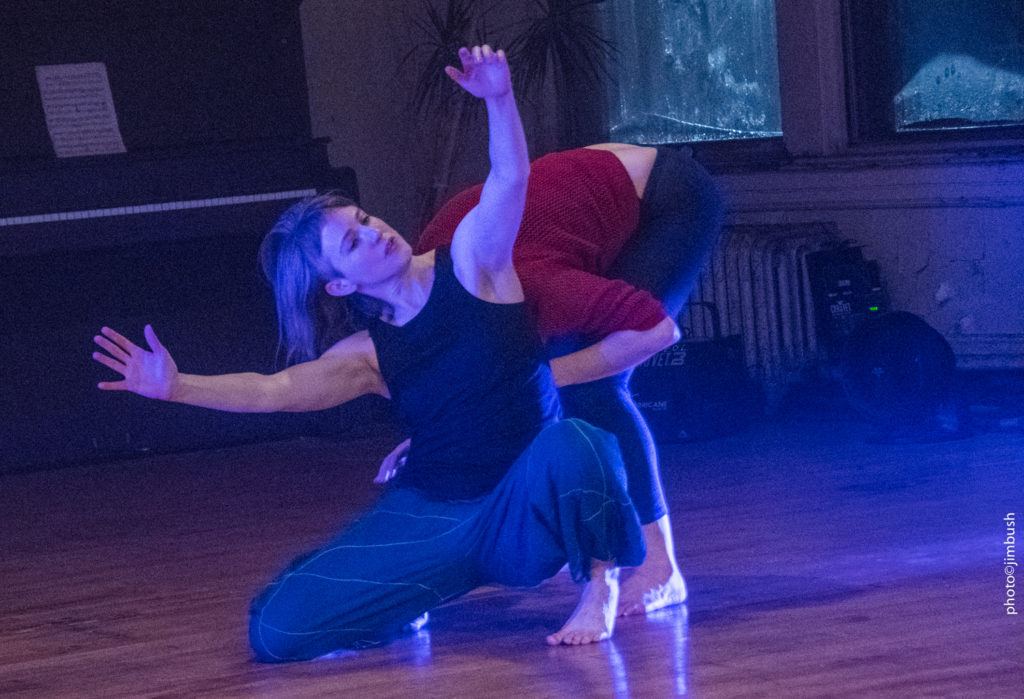What new movement possibilities unfold when we reach into the structure, support and momentum of other dancers?
I am endlessly moved by the way contact improvisation tunes my awareness and calls forth a vibrant string of spontaneous creative decisions. Since I first discovered CI in 1998, it has been a central practice in my life.
CI Teaching Philosophy
As a teacher of CI, I believe in offering an inclusive class that welcomes all body types, genders, ages, and abilities/disabilities. To this end, I use very few “contact choreographies” or set movement pathways as a mode of teaching, preferring instead to teach through movement principles, scores, structures, and states.
Topics I teach on include:
CI fundamentals, composition for an internal audience, game structures and other spontaneous scores, rhythm, and of course, gender.
Sample workshop descriptions:
Finding the Game
It happens when something catches our attention in our dancing and we repeat it, vary it, build on it. We create a set of unspoken rules and play within their limits. Sometimes our dance partner, or someone in another duet, or people all over the room, catch on and join in. Sometimes we co-create the game wordlessly with others. Through the spirit of play we develop a composition. In this workshop, we will explore this notion of “finding the game” in our solo dancing, our CI duets, and our group/jam interactions.
Rhythm in CI
While CI is not a rhythmic dance in the traditional sense of moving to a consistent beat, there are all sorts of rhythms available to us in our contact dancing – from our hearts beating to our breath moving in and out, from our footsteps on the floor to the timing of our weight shifts with our partners. Audible and felt, internal and external, contact improvisation is full of rhythmic elements. With a little attention to our timing, speed, patterns, etc. we can begin to play consciously with composing rhythm in our CI dancing. In this workshop, we will heighten our awareness of rhythmic possibilities in our CI dancing and then play with the rhythms of our own solos, of our interactions with our partner(s), and of our connections to the room as a whole.
(Un)Doing Gender in CI
Contact Improvisation is about responding in the moment, playing with the possibilities, creating with what we find, and using our full physical capacity to navigate the situations that present themselves. Within this form, we have tremendous freedom to move our bodies and to discover different dynamics of dances. But, what if we are holding ourselves back from the full range of possibilities in our dancing, in ways we do not even realize? Gendered patterns of movement and interaction play a larger role in CI dancing than one might think, given that CI is a form without any proscribed gender roles. In our days together, we will seek to deepen our CI dancing, strengthen our technique, and expand the range of dances we have by discovering how gender lives in our movement and building strategies to undo the ways it limits us.
Queering the Jam: Unfolding the story of gender in our dancing
In the story of CI, Steve Paxton created a dance about physics and connection. Gender played no role. Anyone could dance in any way.
And yet we bring our whole selves to our dancing. We bring who we want to be, and who we were taught to be. We encounter what others expect us to be.
Gender creeps in…
And that’s not necessarily bad. We can play with gender in CI, stretching and subverting its norms, delighting in its many qualities, stepping outside our daily identities.
But we also can dance out ideas that we don’t necessarily believe in, deeply buried ideas that come out in ways that limit our dancing or that of those around us.
What is the gendered story of your dancing? Where do you encounter gendered behavior or ideas in your movement and your relationship to others? Are these the stories you want to tell?
Let’s explore together and may this unearthing of stories create more freedom in our dancing!
Gender and Improvisation (interactive lecture)
Our bodies carry both conscious and deeply embodied notions of gender. How do these ideas and behaviors influence the choices we make in our dancing? Where do they expand and where do they limit our possibilities? Even in a dance form as inherently un-gendered as contact improvisation, how do notions of masculinity, femininity, genderqueerness, etc. shape the decisions we make (and the decisions we see available to us)? In this interactive lecture, we will examine how gender influences the ways in which we organize and use our bodies and the roles we take on and off the dance floor.
Lab Process
This workshop offers a structure for us each to dig into the questions that are alive in our dancing. Using a combination of moving, writing, and talking, we will bring to the surface and explore our curiosities, frustrations, delights, and rough edges. Bring ideas that have bubbled up recently in your dancing or use the lab process to uncover interests that you can carry forth into future dancing.
Awakening to Action: Contact Improvisation
Touch connects bodies as they tumble with the force of gravity and the momentum of their own movement. Sensing through their skin, the dancers shift, spiral, soften, and reach. Whether you are a new dancer or a long time contact improviser, what captures your interest in this dance? This workshop proposes to investigate the process of getting interested, deeply interested, in every moment, opening our perception to the myriad details that provide inspiration for improvisation. Building on this lust for detail, how can we, in the moment of moving and perceiving, follow our interests into the unknown? What physical skills do we need to survive the dance that results?
Perceiving Composition (interactive lecture)
What do you think about when you hear the word “composition”? Is composition all about shaping your dance for an outside eye? What role does the kinesthetic play in composition? In this talk, we will explore ways in which composition in improvisation and more specifically in contact improvisation can be driven by perception of what is already happening in the space and of kinesthetic impulses one’s body. Inspired by Nancy Stark Smith’s approach to composition in contact improvisation, we will begin by noticing the compositions already present in the space, cultivating our ability to enjoy accidental connections and awakening our impulses to join in the compositions around us.
Perceiving Composition (workshop)
What compositions are already present in the room? Tuning our awareness to shape, color, energy, direction, etc. we will perceive the relationships between our bodies, the space, and the movements of others. Building upon our perceptions, we will play with ways of responding to and joining in these relationships, folding these compositional impulses in with the kinesthetic impulses that we receive through contact with our partners.
Sinking Into Dynamic Contact
In this workshop, we will slow down and take the time to listen deeply to our physical contact, slowing down enough to allow us to find the doorways to new movement pathways. Traveling pathways new and old, we’ll explore the dynamics and tempo of our dancing – sampling the many possible flavors of the dance – playing with the contrasts between sharpness, floating, resistance, surrender, connection, and separation.
Ready for Anything
The cat ready to pounce…The ball player ready to catch, run, dodge, or block… The jazz musician ready to jam… In this class we will cultivate our “state of readiness,” a state in which we are available to say yes to our partner, to an opportunity, to a shift, to gravity– a place from which we can meet our partners quickly in falling, flight, support and whimsy.
Photos by Patrick Beelaert, Jim Bush, Kah Chong, Carolina Frank, Abraham Noé-Hays, Kikuye Sugiyama

